ICSE Biology Previous Year Question Paper 2014 Solved for Class 10
ICSE Paper 2014 BIOLOGY
SECTION-I (40 Marks)
(Attempt all questions from this Section.)
Question 1:
(a) Name the following :
(i) The part of the brain associated with memory.
(ii) The ear ossicle which is attached to the tympanum.
(iii) The type of gene, which in the presence of a contrasting allele is not expressed.
(iv) The hormone secreted by islets of langerhans.
(v) The process of conversion of ADP into ATP during photosynthesis. [5]
(b) State the main function of the following :
(i) Cerebrospinal fluid
(ii) Eustachian tube
(iii) Suspensory ligament of the eye
(iv) Sperm duct
(v) Lenticels. [5]
(c) Copy and complete the following by filling in the blanks 1 to 5 with appropriate words:
The human female gonads are ovaries. A maturing egg in the ovary is present in a sac of cells called ……… (1). As the egg grows larger, the follicle enlarges and gets filled with a fluid and is now called the ……… (2) follice. The process of releasing the egg from the ovary is called ……… (3). The ovum is picked up by the oviducal funnel and fertilization takes place in the ……… (4). In about a week the blastocyst gets fixed in the endometrium of the uterus and this process is called …….. (5). [5]
(d) Given below are six sets with four terms each. In each set one term is odd and cannot be grouped in the same category to which the other three belong. Identify the odd one in each set and name the category to which the remaining three belong. The first one has been done as an example.
Example: Calyx, Corolla, Stamens, Midrib
Odd term: midrib
Category : parts of a flower.
(i) Haemoglobin, Glucagon, Iodopsin, Rhodopsin.
(ii) Urethra, Uterus, Urinary bladder, Ureter.
(iii) Transpiration, Photosynthesis, Phagocytosis, Guttation.
(iv) Cyton, Photon, Axon, Dendron.
(v) Oxytocin, Insulin, Prolactin, Progesterone. [5]
(e) The figure given below represents an experimental set up with a weighing machine to demonstrate a particular process in plants. The experimental set up was placed in bright sunlight. Study the diagram and answer the following questions:
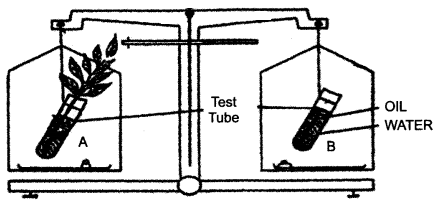 (i) Name the process intended for study.
(i) Name the process intended for study.
(ii) Define the above mentioned process.
(iii) When the weight of the test tube (A & B) is taken before and after the experiment, what is observed ? Give reasons to justify your observation in A &B.
(iv) What is the purpose of keeping the test tube B in the experimental set up ? [5]
(f) Match the items given in Column A with the most appropriate ones in Column B and rewrite the correct matching pairs from Column A and Column B :
| Column A | Column B |
| (1) Pituitary gland | (a) Testosterone |
| (2) Sulphur dioxide | (b) Calcium |
| (3) Seminiferous tubules | (c) Growth hormone |
| (4) Clotting of blood | (d) Acid rain |
| (5) Guttation | (e) Sperms |
| (f) Global warming | |
| (g) Magnesium | |
| (h) Hydathodes |
(g) Choose the correct answer from the four options given below :
(i) Cretinism and Myxoedema are due to :
(A) Hyper secretion of thyroxin (B) Hyper secretion of growth hormone (C) Hyposecretion of thyroxin (D) Hyposecretion of growth hormone.
(ii) Which of the following is not a natural reflex action ?
(A) Knee-jerk (B) Blinking of eyes due to strong light (C) Salivation at the sight of food (D) Sneezing when any irritant enters the nose.
(iii) After mitotic cell division, a female human cell will have :
(A) 44 + xx chromosome. (B) 44 + xy chromosome (C) 22 + x chromosome (D) 22 + y chromosome.
(iv) The antibiotic penicillin is obtained from :
(A) Protozoan (B) Bacteria (C) Virus (D) Fungus
(v) The site of maturation of human sperms is the :
(A) Seminiferous tubule (B) Interstitial cells (C) Epididymis (D) Prostate gland. [5]
(h) State the exact location of the following :
(i) Tricuspid value
(ii) Amnion.
(iii) Yellow spot
(iv) Seminal vesicle
(v) Adrenal gland [5]
Answer :
(a) (i) Cerebrum
(ii) Malleus/Hammer
(iii) Recessive gene
(iv) Insulin, Glucagon
(v) Photophosphorylation.
(b) (i) Provide mechanical protection to brain or to provide nourishment to brain.
(ii) Maintain/Equalize air pressure on either sides of the ear drum.
(iii) Hold the lens in position.
(iv) Transport sperm from the epididymis to penis for discharge.
(v) To facilitate transpiration in older stem.
(c) The human female gonads are ovaries. A maturing egg in the ovary is present in a sac of cells called ovarian follicle (1). As the egg grows larger, the follicle enlarges and gets filled with a fluid and is now called the Graafian (2) follicle. The process of releasing the egg from the ovary is called ovulation (3). The ovum is picked up by the oviducal funnel and fertilization takes place in the oviduct (4). In about a week the blastocyst gets fixed in the endometrium of the uterus and this process is called implantation (5).
(d) (i) Odd term: Glucagon
Category: Pigments
(ii) Odd term: Uterus
Category: Parts of excretory system
(iii) Odd term: Phagocytosis
Category: Processes in plants
(iv) Odd term: Photon
Category: Parts of a neuron.
(v) Odd term: Insulin
Category: Female reproductive/sex hormona.
(e) (i) Transpiration.
(ii) It is the process in which water is lost in the form of vapour from the aerial parts of the plant.
(iii) After the experiment, we observe test tube A is raised up i.e., a loss of weight. In test tube B, the weight remains unchanged.
Reason: In test tube A, loses weight due to the plant transpires and loses water. In B there is no plant so there is no transpiration and the oil on the surface prevents direct evaporation and so weight remains unchanged.
(iv) As a control experiment.
(f)
| Column A | Column B |
| (1) Pituitary gland | (c) Growth hormone |
| (2) Sulphur dioxide | (d) Acid rain |
| (3) Seminiferous tubules | (e) Sperms |
| (4) Clotting of blood | (b) Calcium |
| (5) Guttation | (h) Hydathodes |
(g) (i) (C) Hyposecretion of thyroxin
(ii) (C) Salivation at the sight of food
(iii) (A) 44 + xx chromosome.
(iv) (D) Fungus
(v) (C) Epididymis
(h) (i) Tricuspid value: Between right auricle and right ventricle.
(ii) Amnion: Arouhd the foetus in the uterus.
(iii) Yellow spot: Exactly behind the lens on the retina of the eye.
(iv) Seminal vesicle: Between urinary bladder and rectum in male.
(v) Adrenal gland: Above each kidney fitted like a cap.
SECTION-II (40 Marks)
(Attempt any Four questions from this Section)
Question 2:
(a) Differentiate between the following pairs on the basis of what is mentioned within brackets:
(i) Spinal nerves and Cranial nerves (Number of nerves)
(ii) Near vision and Distant Vision (shape of the eye lens)
(iii) Corpus callosum and Corpus luteum. (function)
(iv) Turgor pressure and wall pressure. (Explain)
(v) Disinfectant and Antiseptic (Definition) [5]
(b) The diagram below represents the simplified pathway of the circulation of blood. Study the same and answer the questions that follow :
 (i) Name the blood vessels labelled 1 and 2.
(i) Name the blood vessels labelled 1 and 2.
(ii) State the function of blood vessels labelled 5 and 8.
(iii) What is the importance of the blood vessel labelled 6 ?
(iv) Which blood vessel will contain a high amount of glucose and amino acids after a meal ?
(v) Draw a diagram of the different blood cells as seen in a smear of human blood. [5]
Answer:
(a) (i) Spinal nerves: 31 pairs.
Cranial nerves: 12 pairs
(ii) Near vision: More convex/too curved.
Distant vision: Less convex/too flat.
(iii) Corpus callosum: Connect the left and right cerebral hemispheres.
Corpus luteum: Secrete female sex hormones Oesterogen and progesterone.
(iv) Turgor pressure: The pressure exerted by cell contents of a turgid cell on the cell wall.
Wall pressure: The pressure exerted by the wall of a turgid cell on the cell contents.
(v) Disinfectant: These are chemicals of strong concentration applied on spots and areas to kill germs.
Antiseptic: These are chemicals of mild concentration applied on the body to kill germs.
(b) (i) (1) Anterior/Superior venacava (2) Dorsal aorta
(ii) Function of 5: Supply oxygenated blood to liver.
Function of 8: Cajry deoxygenated blood from posterior parts of the body to the right auricle of heart.
(iii) Importance of the blood vessel labelled 6: Blood vessel 6 is called Hepatic portal vein. It carries deoxygenated blood from intestine to liver. This blood contains excess glucose, some toxic substances etc. which are sent to liver where they are detoxified and the excess glucose is converted to glycogen and stored. This prevents these substances from directly entering the heart and damaging the heart.
(iv) Blood Vessel-6
(v)
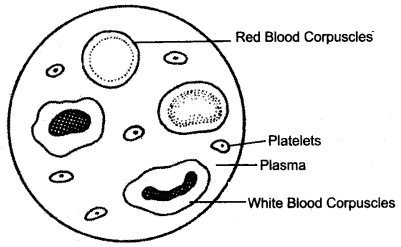
Question 3:
(a) A candidate in order to study the process of osmosis has taken 3 potato cubes and put them in 3 different beakers containing 3 different solutions. After 24 hours, in the first beaker the potato cube increased in size, in the second beaker the potato cube decreased in size and in the third beaker there was no change in the size of the potato cube. The following diagram shows the result of the same experiment:
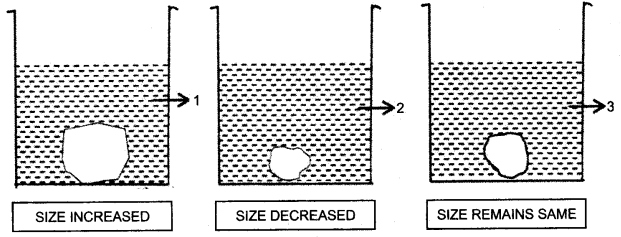 (i) Give the technical terms of the solutions used in beakers, 1, 2, and 3.
(i) Give the technical terms of the solutions used in beakers, 1, 2, and 3.
(ii) In beaker 3 the size of the potato cube remains the same. Explain the reason in brief.
(iii) Write the specific feature of the cell sap of root hairs which helps in absorption of water.
(iv) What is osmosis ?
(v) How does a cell wall and a cell membrane differ in their permeability ? [5]
(b) A potted plant was taken in order to prove a factor necessary for photosynthesis. The potted plant was kept in the dark for 24 hours. One of the leaves was covered with black paper in the centre. The potted plant was then placed in sunlight for a few hours.
(i) What aspect of photosynthesis was being tested ?
(ii) Why was the plant placed in the dark before beginning the experiment ?
(iii) During the starch test why was the leaf:
(1) boiled in water.
(2) boiled in methylated spirit.
(iv) Write a balanced chemical equation to represent the process of photo-synthesis.
(v) Draw a neat diagram of a chloroplast and label its parts. [5]
Answer:
(a) (i) (1) Hypotonic solution.
(2) Hypertonic solution.
(3) Isotonic solution.
(ii) In beaker 3, the concentration of potato cube and the medium is same. So there is no osmosis taking place therefore the size of cube remains same.
(iii) The concentration of cell sap is higher in the root hair as compared to soil water due to endosmoses is takes place facilitating absorption of water.
(iv) Osmosis is a process of flow of solvent molecules from lower concentration to higher concentration through a semipermeable membrane.
(v) Cell wall is freely permeable and cell membrane is semi-permeable.
(b) (i) Sunlight is necessary for photosynthesis.
(ii) To make the leaves free from starch.
(iii) 1. To kill the cells.
2. To remove the chlorophyll.
(iv)

(v)
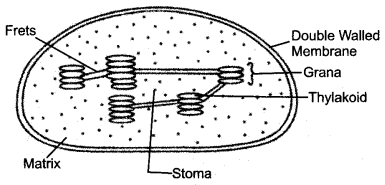
Question 4:
(a) The diagram given below is a representation of a certain phenomenon pertaining to the nervous system. Study the diagram and answer the following questions :
 (i) Name the phenomenon that is being depicted.
(i) Name the phenomenon that is being depicted.
(ii) Give the technical term for the point of contact between the two nerve cells.
(iii) Name the parts 1, 2, 3 and 4.
(iv) Write the functions of parts 5 and 6.
(v) How does the arrangement of neurons in the spinal cord differ from that of the brain ? [5]
(b) Give scientific reasons for the following statements :
(i) Use of C.F.C is banned in many countries.
(ii) We cannot distinguish colours in moonlight.
(iii) Balsam plants wilt during midday even if the soil is well watered.
(iv) Carbon monoxide is highly dangerous when inhaled.
(v) A person after consuming alcohol walks clumsily. [5]
Answer:
(a) (i) Reflex action.
(ii) Synapse
(iii) 1. Sensory/Afferent neuron.
2. Dorsal ganglion/Dorsal root.
3. White matter
4. Grey matter
(iv) Function of 5 (Synape): Transmit the sensory impulse from sensory neuron to the motor neuron.
Function of 6 (Motor neuron/Efferent neuron): Transmit the command to the effectors (muscle or glands).
(v) In Brain: Gray matter on the outerside and white matter on inner side.
In Spinal cord: White matter on the outerside and Gray matter on inner side.
(b) (i) Chlorifluorocarbons (CFC) are one of the major cause for ozone depletion.
(ii) Moonlight is dimlight during which cone cells of our eye do not function well therefore colour is not perceieved. It is only red cells that function in moonlight.
(iii) It is a herbaceous plant and loses too much of water by exessive transpiration. The rate of transpiration is more than the rate of absorption. So they with weak stem droops and wilts.
(iv) Carbon monoxide has great affinity with haemoglobin of our blood. It mixes with haemoglobin almost 300 times more than that with oxygen. It cuts off the supply of oxygen due to which it is fatal.
(v) Alcohol affects the cerebellum part of the brain which is responsible for muscular co-ordination. So after consuming alcohol due to lack of muscular balance and co-ordination, the person walks clumisly.
Question 5:
(a) Given below is a diagram representing a stage during mitotic cell division. Study it carefully and answer the questions that follow :
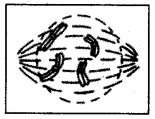 (i) Is it a plant cell or an animal cell ? Give a reason to support your answer.
(i) Is it a plant cell or an animal cell ? Give a reason to support your answer.
(ii) Identify the stage shown.
(iii) Name the stage that follows the one shown here. How is that stage identified ?
(iv) How will you differentiate between mitosis and meiosis on the basis of the chromosome number in the daughter cells ?
(v) Draw a duplicated chromosome and label its parts. [5]
(b) (i) Name the disease for which the following of vaccines are given :
(1) Salk’s Vaccine.
(2) B.C.G.
(ii) Give one example of each of the following :
(1) A water pollutant.
(2) An aquatic plant used in the lab to demonstate O2 liberation during photosynthesis.
(3) An antibiotic.
(4) A nitrogenous base in DNA.
(iii) Expand the following biological abbreviations :
(1) ATP (2) TSH (3) DPT (4) DNA [5]
Answer:
(a) (i) Plant cell. Because Cell wall present and Centrioles absent.
(ii) Prophase.
(iii) Metaphase: The chromosomes will be arranged at the equator attached to the spindle fibre.
(iv) In Mitosis : The chromosome number in daughter cell is same as that of the mother cell i.e., diploid mother cell gives rise to 2 diploid daughter cells.
In Meiosis : The chromosome number is halved in the daughter cells i.e., the diploid mother cell gives rise to four haploid daughter cells.
(v)
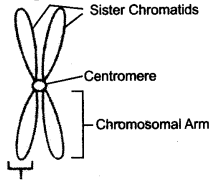
(b) (i) 1. Poliomyelitis
2. Tuberculosis
(ii) 1. Chemicals like Mercury from Industries.
2. Hydrilla.
3. Penicillin
4. Adenine
(iii) 1. ATP: Adenosine triphosphate.
2. TSH: Thyroid stimulating hormone.
3. DPT: Diphtheria Pertussis Tetanus.
4. DNA: Deoxyribonucleic acid.
Question 6:
(a) The given diagram represents a nephron and its blood supply. Study the diagram and answer the following questions :
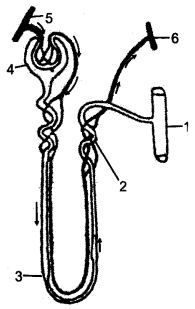 (i) Label parts 1, 2, 3 and 4.
(i) Label parts 1, 2, 3 and 4.
(ii) State the reason for the high hydrostatic pressure in the glomerulus.
(iii) Name the blood vessel which contains the least amount of urea in this diagram.
(iv) Name the two main stages of urine formation.
(v) Name the part of the nephron which lies in the renal medulla. [5]
(b) Briefly explain the following terms:
(i) monohybrid cross.
(ii) Biomedical waste
(iii) Innate immunity.
(iv) Diapedesis
(v) Hormones. [5]
Answer:
(a) (i) 1. Collecting duct.
2. Distal convoluted tubule.
3. Loop of Henle.
4. Bowman’s capsule.
(ii) The afferent arteriole splits into many fine branches due to which the volume of capillaries reduce thus raising the hydrostatic pressure in the glomerulus.
(iii) Blood vessel 6-Efferent arteriole that connects to renal vein.
(iv) 1. Ultrafiltration.
2. Selective Reabsorption.
(v) Loop of Henle.
(b) (i) Monohybrid Cross : A cross between two parents taking the alternative traits of one single character. For example, a cross between tall and dwarf pea plants.
(ii) Wastes containing dressings, amputated body parts, used surgical instruments etc. from hospitals, that spread diseases.
(iii) Innate immunity is the immunity that a person inherits from his parents i.e., the person is bom with it.
(iv) The process by which white blood cells squeeze out through the walls of capillaries to reach the site of infection.
(v) Hormones: According to Selye (1948), “Hormones are the physiological organic compounds produced by certain cells for the sole purpose of directing the activities to distant parts of the same origins.”
Question 7:
(a) (i) State any two harmful effects of noise pollution on human health.
(ii) Categorize the following activities as per the functions of the Red Cross Society and the WHO :
(1) To suggest quarantine measures to prevent spread of disease.
(2) Humanitarian services to victim of war.
(3) To educate people in accident prevention.
(4) To promote projects for research on disease.
(iii) Write any two major reasons for the population explosion in India.
(iv) State Mendel’s Law of segregation. [5]
(b) Give technical terms for the following :
(i) A method of contraception in which the sperm duct is cut and ligated.
(ii) Statistical study of human population.
(iii) The protective covering of the heart.
(iv) A sudden heritable change in the gene.
(v) Repeated units of DNA molecule.
(vi) The fluid portion of blood.
(vii) The nerve that transmits impulses from the ear to the brain.
(viii) Group of hormones which influence other endocrine glands to produce hormones.
(ix) Thin walled sac of skin that covers the testes.
(x) The permanent stoppage of the menstrual cycle in a woman aged 50 years. [5]
Answer:
(a) (i) Two harmful effects of noise pollution:
1. Cause hearing disorder.
2. Cause high blood pressure.
(ii) 1. WHO
2. Red Cross
3. Red Cross
4. WHO
(iii) 1. Desire for a male child.
2. Illiteracy and Lack of awareness about birth control measures.
(v) This law states that in a monohybrid cross, the contrasting characters or factors separate/or segregate from each other at the time of gamete formation.
(b) (i) Vasectomy
(ii) Demography
(iii) Pericardium
(iv) Mutation
(v) Nucleotide
(vi) Plasma
(vii) Auditory nerve
(viii) Tropic hormones
(ix) Scrotum
(x) menopause.
